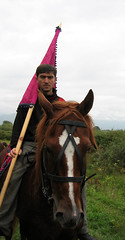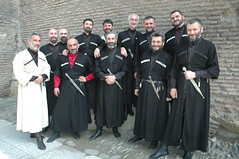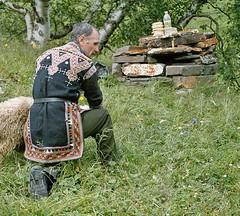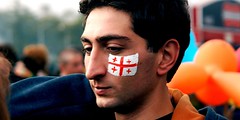This topic was suggested to us by a reader. I had seen some of Prokudin-Gorskii's fascinating photographs before, but I hadn't realised to what extent he had made portraits of handsome Central Asian men ...
Sergei Mikhailovich Prokudin-Gorskii (1863-1944) was an innovator in colour photography. In the early 1900's, he formulated an ambitious plan to document the Russian Empire in full colour. He wanted to educate the empire's young citizens of its vast and diverse history, culture and modernization.
Tsar Nicholas II supported this project, and in 1909-1912, and again in 1915, Prokudin-Gorskii completed surveys of eleven regions, traveling in a specially equipped railroad car provided by the Ministry of Transportation.
According to
Wikipedia, "his process used a camera that took a series of monochrome pictures in rapid sequence, each through a different colored filter. By projecting all three monochrome pictures using correctly-colored light, it was possible to reconstruct the original color scene. Any stray movement within the camera's field of view showed up in the prints as multiple "ghosted" images, since the red, green and blue images were taken of the subject at slightly different times.
He also successfully experimented with making color prints of the photographs, but the process was complicated and slow. It was only with the advent of digital image processing that multiple images could be satisfactorily combined into one."
The resulting images give a unique insight to an era we are used to seeing in monochrome only.
The
Library of Congress has made a large amount of his photographs of landscapes, architectural monuments, industry, transportation and people available on their site. Here is a small, unsorted selection of his portraits from the vast Russian Empire ... Click to see them larger.

A fabric merchant in Samarkand. Note the framed Koran page above the stall.

Georgian tomato merchant near Sochi.

On the
Registan, Samarkand.

A tea room in Samarkand.

A shashlyk restaurant in Samarkand.

A shepherd outside Samarkand.

At the Salyuktin mines on the outskirts of Samarkand.

A carpenter in Samarkand.

Fat tail sheep on the
Golodnaya steppe.

Nazar Magomet, Golodnaya steppe. Note the doggie!

A Turkmen man posing with a camel loaded with sacks, probably of grain or cotton. Camel caravans remained the most common means of transporting goods in Central Asia well into the railroad era.

A young Bashkir.

A Bashkir switchman near the town of Ust' Katav on the Yuryuzan River between Ufa and Chelyabinsk in the Ural Mountain region of European Russia.

Packaging department, Borzhom (today's Borjomi, Georgia).

A man in a courtyard, place unknown.

A shashlyk restaurant, Samarkand.

Doctors in Samarkand.

Mullahs by a mosque, Azizia, Batumi.

A Sunni Muslim man of undetermined nationality in Dagestan.
Finally, here is a black and white photograph, which nonetheless has very interesting subjects ...

Barbers in the Registan, Samarkand.





























































